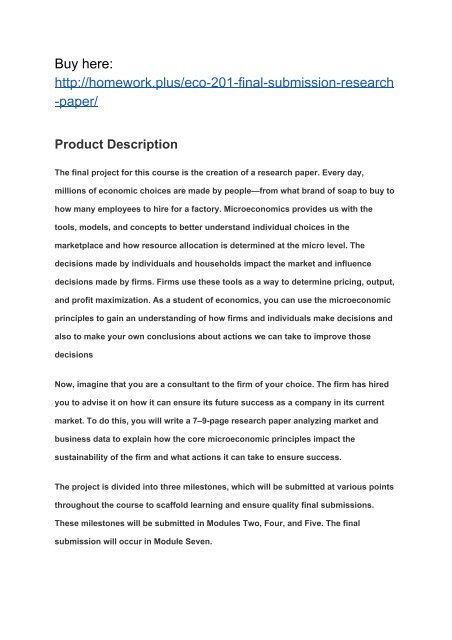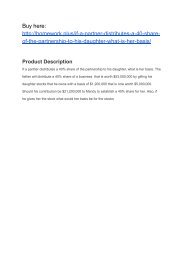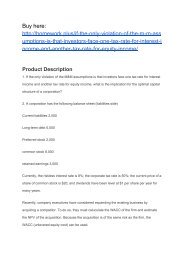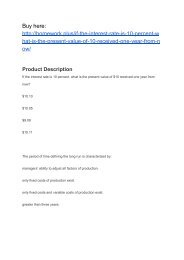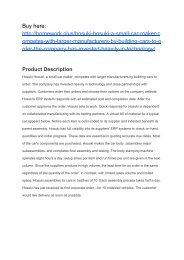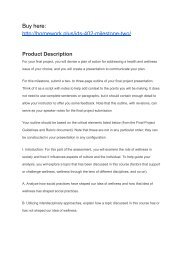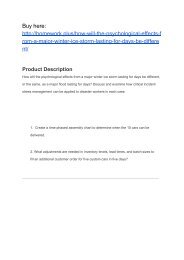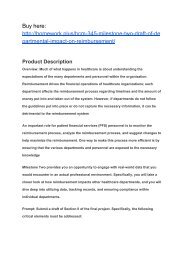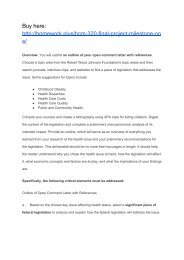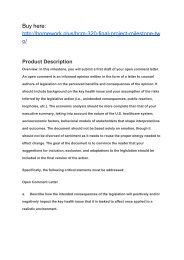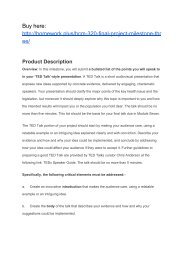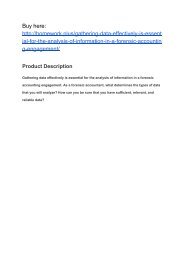ECO 201 Final Submission Research Paper
ECO 201 Final Submission Research Paper
ECO 201 Final Submission Research Paper
Create successful ePaper yourself
Turn your PDF publications into a flip-book with our unique Google optimized e-Paper software.
Buy here:<br />
http://homework.plus/eco-<strong>201</strong>-final-submission-research<br />
-paper/<br />
Product Description<br />
The final project for this course is the creation of a research paper. Every day,<br />
millions of economic choices are made by people—from what brand of soap to buy to<br />
how many employees to hire for a factory. Microeconomics provides us with the<br />
tools, models, and concepts to better understand individual choices in the<br />
marketplace and how resource allocation is determined at the micro level. The<br />
decisions made by individuals and households impact the market and influence<br />
decisions made by firms. Firms use these tools as a way to determine pricing, output,<br />
and profit maximization. As a student of economics, you can use the microeconomic<br />
principles to gain an understanding of how firms and individuals make decisions and<br />
also to make your own conclusions about actions we can take to improve those<br />
decisions<br />
Now, imagine that you are a consultant to the firm of your choice. The firm has hired<br />
you to advise it on how it can ensure its future success as a company in its current<br />
market. To do this, you will write a 7–9-page research paper analyzing market and<br />
business data to explain how the core microeconomic principles impact the<br />
sustainability of the firm and what actions it can take to ensure success.<br />
The project is divided into three milestones, which will be submitted at various points<br />
throughout the course to scaffold learning and ensure quality final submissions.<br />
These milestones will be submitted in Modules Two, Four, and Five. The final<br />
submission will occur in Module Seven.
In this assignment, you will demonstrate your mastery of the following course<br />
outcomes:<br />
Apply microeconomic models to real-world situations for informing effective business<br />
decisions<br />
Analyze business and market data using microeconomic tools for their impact on<br />
business sustainability<br />
Evaluate the structure of various markets for informing effective decision-making<br />
strategies<br />
Assess the behavior and decisions of individuals and firms for their relation to the<br />
microeconomic framework<br />
You will work with your instructor to choose a firm for which you can find reliable<br />
data and information, both at the firm level and the industry level. The firm you select<br />
must be a publicly traded company, must operate in the U.S. market, and must<br />
currently be in business. You will need instructor approval before continuing on with<br />
your research paper in order to ensure you have met the necessary requirements.<br />
Publicly traded companies file reports with a great deal of data that you will find<br />
useful for your analysis. Once you have selected a firm for your case study, you will<br />
gather information and data relevant to the firm and its industry and use the core<br />
microeconomic principles you have learned in class to analyze the information and<br />
make a recommendation for your firm. You will compose a 7–9-page research paper in<br />
which you will analyze the market and business data to explain how the core<br />
microeconomic principles impact the sustainability of the firm, and your<br />
recommendation will suggest the actions the firm can take to ensure success<br />
Specifically the following critical elements must be addressed:
I. Introduction<br />
Work with your instructor to choose a firm that matches the following criteria: a<br />
publicly traded company operating in the U.S. market that is currently in<br />
business.<br />
a) Outline the purpose of this paper and how it will inform your conclusion.<br />
b) Summarize the history of the firm, and provide an overview for what the firm does<br />
and what goods/services it sells.<br />
II. Explore the supply and demand conditions for your firm’s product.<br />
a) Evaluate trends in demand over time, and explain their impact on the industry and<br />
the firm. You should consider including annual sales figures<br />
for the product your firm sells.<br />
b) Analyze information and data related to the demand and supply for your firm’s<br />
product(s) to support your recommendation for the firm’s<br />
actions. Remember to include a graphical representation of the data and information<br />
used in your analysis.<br />
III. Examine the price elasticity of demand for the product(s) your firm sells.<br />
a) Analyze the available data and information, such as pricing and the availability of<br />
substitutes, and justify how you determine the price elasticity<br />
of demand for your firm’s product.
) Explain the factors that affect consumer responsiveness to price changes for this<br />
product, using the concept of price elasticity of demand as your<br />
guide.<br />
c) Assess how the price elasticity of demand impacts the firm’s pricing decisions and<br />
revenue growth.<br />
IV. Examine the costs of production for your firm.<br />
a) Analyze the various costs a firm faces, their trends over time, and how they have<br />
impacted your firm’s profitability.<br />
b) Apply the concepts of variable and fixed costs to your firm for informing its output<br />
decisions. For instance, analyze how different kinds of costs<br />
(labor, research and development, raw materials) affect the firm’s level of output.<br />
V. Explore the overall market for your firm.<br />
a) Discuss the market share of the firm and its top competitors by providing details on<br />
current percentages for each firm and describing the trend<br />
over time. You might consider presenting the data graphically.<br />
b) Analyze the barriers to entry in this market to illustrate the potential for new<br />
competition and its impact on your firm’s future in the market.<br />
c) Describe the market structure for this firm, and analyze how this affects the firm’s<br />
ability to influence the market.<br />
VI. Recommendation
a) Develop a recommendation for how the firm can manage its future production by<br />
synthesizing the data presented.<br />
b) Suggest how the firm’s position within the market and among its competitors will<br />
allow it to take your recommended action.<br />
c) Describe how the firm can sustain its success going forward by evaluating the<br />
findings from demand trends and price elasticity.


